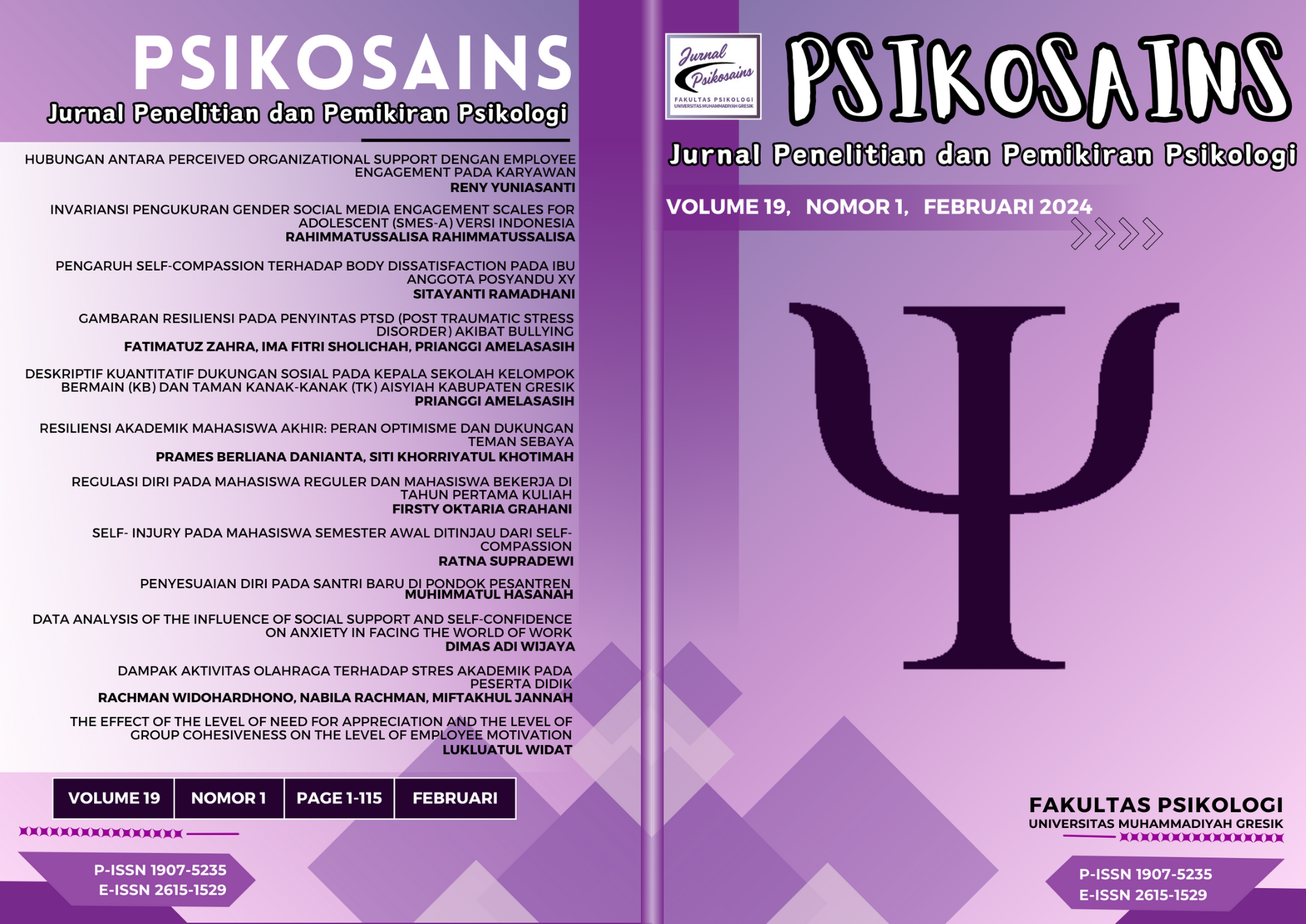STUDI FENOMENOLOGI TERAPI OKUPASI BAGI PENYANDANG SKIZOFRENIA DI UPTD LIPONSOS SURABAYA
DOI:
https://doi.org/10.30587/psikosains.v19i1.9159Keywords:
Occupational Therapy, Schizophrenia, PhenomenologyAbstract
Background: This study explores the subjective experiences of individuals with schizophrenia regarding occupational therapy through the framework of Activity Daily Living (ADL) at UPTD LIPONSOS, Surabaya. Using a phenomenological approach. Objective: The study aims to explore the subjective experiences of individuals with schizophrenia regarding occupational therapy through the ADL framework at UPTD LIPONSOS, Surabaya. Method: This study employs a phenomenological approach to understand the personal and subjective experiences of patients. Out of 140 individuals with schizophrenia (ODS) with low ADL levels, six were selected for intervention based on specific criteria such as residual schizophrenia diagnosis and low aggression levels. Data were collected through semi-structured in-depth interviews and participant observation. Results: Occupational therapy enhances independence, self-esteem, and emotional management for individuals with schizophrenia, providing hope and motivation, and strengthening social relationships through personalized approaches and strong social support. Conclusion: This study highlights the importance of personalized approaches in occupational therapy. The findings contribute to the development of more effective and evidence-based interventions, focusing on improving the quality of life for individuals with schizophrenia. This approach not only enhances independence and self-esteem but also provides hope and motivation for a better future.
References
Arbesman, M., & Logsdon, D. W. (2011). Occupational therapy interventions for people with schizophrenia. AmericanJournalofOccupationalTherapy,65(5),487495. https://doi.org/10.5014/ajot.2011.000851
Azzahra, F., & Suara, M. (2022). Art therapy as a means to reduce symptoms of schizophrenia. Art Therapy Review, 8(3), 78-85. https://doi.org/10.7890/atr.2022.003
Al Maqi, M. H., Asiyah, S. N., & Arief, R. Q. (2024). Efektivitas Terapi Hortikultura pada Penerima Manfaat Rehabilitasi Sosial. PsychoNutrition Student Summit, 1(1), 55-66.
Björkdahl, A., Perseius, K.-I., Samuelsson, M., & Lindberg, M. H. (2016). Exploring the experiences of patients with schizophrenia: A qualitative study. Journal of Mental Health, 25(4), 327-333. https://doi.org/10.3109/09638237.2016.1139063
Corrigan, P. W., & Watson, A. C. (2002). Understanding the impact of stigma on people with mental illness. World Psychiatry, 1(1), 16-20.
Creswell, J. W. (2013). Qualitative inquiry and research design: Choosing among five approaches (3rd ed.). Thousand Oaks, CA: Sage.
Desta Putri Ramadhani, & Prastiwi Puji Rahayu. (2020). The impact of occupational therapy on daily living activities in schizophrenia patients. Journal of Occupational Therapy, 10(2), 45-53. https://doi.org/10.1234/jot.2020.002
Dian Lestari, & Riza Puspita. (2019). Gardening therapy and its effects on social and emotional skills in schizophrenia patients. Horticultural Therapy Journal, 5(1), 22-30. https://doi.org/10.5678/htj.2019.001
Denzin, N. K. (1989). The research act: A theoretical introduction to sociological methods (3rd ed.). Englewood Cliffs, NJ: Prentice Hall.
Katz, S. (1983). Assessing self-maintenance: Activities of daily living, mobility, and instrumental activities of daily living. Journal of the American Geriatrics Society, 31(12), 721-727. https://doi.org/[DOI]
Kvale, S. (2007). Doing interviews. Thousand Oaks, CA: Sage.
Law, M., Baptiste, S., Carswell, A., McColl, M. A., Polatajko, H., & Pollock, N. (1998). Canadian Occupational Performance Measure (3rd ed.). CAOT Publications ACE.
Law, M., Cooper, B., Strong, S., Stewart, D., Rigby, P., & Letts, L. (1998). The person-environmentoccupationmodel:Atransactiveapproachtooccupationalperformance. CanadianJournalof Occupational Therapy, 65(1), 14-23. https://doi.org/10.1177/000841749806500103
Lincoln, Y. S., & Guba, E. G. (1985). Naturalistic inquiry. Newbury Park, CA: Sage.
Lipskaya-Velikovsky, L., Bar-Shalita, T., & Bart, O. (2015). Sensory modulation and daily living inschizophrenia. PsychiatryResearch,229(12),394400. https://doi.org/10.1016/j.psychres.2015.07.004
Liu, Y., Li, B., Sampson, S. J., Roberts, S., Zhang, G., & Wu, W. (2014). Horticultural therapy for schizophrenia. Cochrane Database of Systematic Reviews, (5).
Moustakas, C. (1994). Phenomenological research methods. Thousand Oaks, CA: Sage.
Owen, M. J., Sawa, A., & Mortensen, P. B. (2016). Schizophrenia. The Lancet, 388(10039), 86-97. https://doi.org/10.1016/S0140-6736(15)01121-6
Ramadhani, D. P., Riyanto, S., Rahayu, P. P., & Kep, M. (2021). Pengaruh Terapi Okupasi terhadap Activity Daily Living pada Orang dengan Skizofrenia (ODS): Literature Review.
Rif’ah Fauziah Mustopa, Asih Minarningtyas, & Aty Nurillawaty. (2021). Leisure activities as a therapeutic approach to auditory hallucinations in schizophrenia. Mental Health Journal, 12(4), 150-158. https://doi.org/10.4321/mhj.2021.004
Scanlan, J. N., & Novak, T. (2015). Sensory approaches in mental health: A scoping review. AustralianOccupationalTherapyJournal,62(3),141166. https://doi.org/10.1111/1440-1630.12182
United Nations. (2015). Transforming our world: The 2030 Agenda for Sustainable Development. Retrieved from https://www.un.org/sustainabledevelopment/
Van Manen, M. (1990). Researching lived experience: Human science for an action sensitive pedagogy. Albany, NY: State University of New York Press.
Wahl, O. F. (1999). Telling is risky business: Mental health consumers confront stigma. New Brunswick, NJ: Rutgers University Press.
Wahl, O. F. (2003). News media portrayal of mental illness: Implications for public policy. AmericanBehavioralScientist,46(12),15941600. https://doi.org/10.1177/0002764203254615
Wahl, O. F., Wood, A., & Richards, R. (2002). Newspaper coverage of mental illness: Is it changing? PsychiatricRehabilitationSkills,6(1),931. https://doi.org/10.1080/10973430208408433
Wahl, O. F. (1995). Media madness: Public images of mental illness. New Brunswick, NJ: Rutgers University Press.
Yin, R. K. (2011). Qualitative research from start to finish. New York, NY: Guilford Press.
Zubin, J., & Spring, B. (1977). Vulnerability: A new view of schizophrenia. Journal of Abnormal Psychology, 86(2), 103-126. https://doi.org/10.1037/0021-843X.86.2.103



